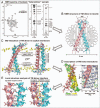Structure elucidation of dimeric transmembrane domains of bitopic proteins
- PMID: 20421711
- PMCID: PMC2900626
- DOI: 10.4161/cam.4.2.11930
Structure elucidation of dimeric transmembrane domains of bitopic proteins
Abstract
The interaction between transmembrane helices is of great interest because it directly determines biological activity of a membrane protein. Either destroying or enhancing such interactions can result in many diseases related to dysfunction of different tissues in human body. One much studied form of membrane proteins known as bitopic protein is a dimer containing two membrane-spanning helices associating laterally. Establishing structure-function relationship as well as rational design of new types of drugs targeting membrane proteins requires precise structural information about this class of objects. At present time, to investigate spatial structure and internal dynamics of such transmembrane helical dimers, several strategies were developed based mainly on a combination of NMR spectroscopy, optical spectroscopy, protein engineering and molecular modeling. These approaches were successfully applied to homo- and heterodimeric transmembrane fragments of several bitopic proteins, which play important roles in normal and in pathological conditions of human organism.
Figures


References
-
- Ubarretxena-Belandia I, Engelman DM. Helical membrane proteins: diversity of functions in the context of simple architecture. Curr Opin Struct Biol. 2001;11:370–376. - PubMed
-
- Schlessinger J. Cell signaling by receptor tyrosine kinases. Cell. 2000;281:211–225. - PubMed
-
- Moriki T, Maruyama H, Maruyama IN. Activation of preformed EGF receptor dimers by ligand-induced rotation of the transmembrane domain. J Mol Biol. 2001;311:1011–1026. - PubMed
Publication types
MeSH terms
Substances
LinkOut - more resources
Full Text Sources
